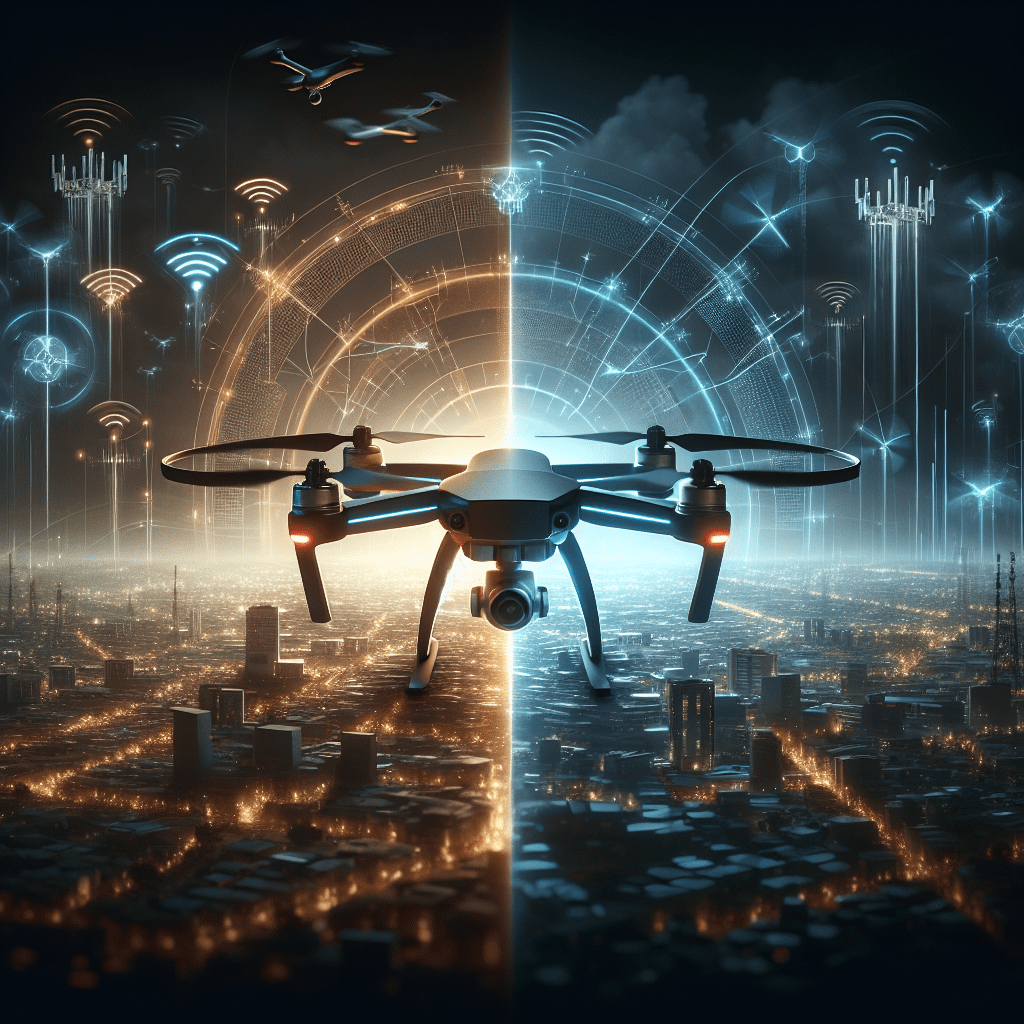Drone Transmission Technology: Wi-Fi vs 5G Showdown
In This Article
- Drone Transmission Technology underpins UAV performance, affecting range, reliability, and real-time control.
- Wi-Fi offers simplicity, affordability, but is limited by range and latency.
- 5G enables BVLOS flight, ultra-low latency, and extensive scalability for professional uses.
- Hybrid protocols allow drones to dynamically select the best transmission method.
- Upcoming tech like 6G, satellite IoT, and AI-based traffic management will revolutionise the field further.
- Costs, energy consumption, and regulatory compliance must be factored into technology selection.
Introduction to Drone Communication Technologies
Main Transmission Protocols Used Today
Drone Transmission Technology has become one of the key enablers of modern unmanned aerial vehicle (UAV) operations. Whether piloting small consumer drones or managing large-scale commercial fleets, the transmission method significantly affects performance, reliability, and utility. The two leading protocols currently in use are Wi-Fi and 5G. Wi-Fi, a historically dominant method, offers simplicity in setup and affordability, whereas 5G promises unparalleled speeds, reliability, and ultra-low latency.
Communication between a drone and its pilot — whether manual or autonomous — relies on solid data links. These connections are responsible for transmitting high-definition video, telemetry data, flight commands, and more. As drones become more sophisticated, their data needs scale accordingly. Today’s UAVs stream 4K or even 8K footage, utilise AI-based object detection, and respond instantly to dynamic environmental changes — all necessitating robust transmission infrastructures.

What Wi-Fi Offers for UAV Streamers
When Cost and Local Coverage Are Priorities
Wi-Fi remains a go-to solution for hobbyists and some light commercial drone operations. Its prevalence in consumer devices ensures ubiquitous compatibility, and it’s often integrated into the UAV and controller itself. Drone Transmission Technology through Wi-Fi offers the advantage of minimal setup and an intuitive user interface — ideal for recreational flying or short-range real-time streaming.
Wi-Fi transmissions typically use the 2.4GHz and 5GHz bands. While these frequencies do support decent data throughput, they come with inherent limitations such as shorter range and susceptibility to interference. In urban environments dense with competing signals, performance can suffer. Nonetheless, for users who require minimal investment and are operating within visual line of sight, Wi-Fi’s benefits are considerable.
“For casual drone enthusiasts or content creators working in short distances, Wi-Fi remains a practical and cost-efficient solution.”
The Power of 5G for Professional Drone Operations
5G has revolutionised Drone Transmission Technology by addressing many of Wi-Fi’s shortcomings. Designed for high-bandwidth, low-latency communication across wide areas, 5G brings several strategic benefits to UAV operators. For instance, 5G supports enhanced mobile broadband (eMBB), ultra-reliable low-latency communication (URLLC), and massive machine-type communication (mMTC).
These capabilities translate into real-world benefits such as extended control range beyond visual line of sight (BVLOS), near-instantaneous response times, and support for mission-critical applications like emergency response, infrastructure inspections, and logistics. Additionally, 5G gives drone operators access to network slicing, allowing dedicated bandwidth channels for UAVs, reducing interference from other users on the same network.
5G in Remote and Time-Critical Applications
Consider scenarios such as agriculture monitoring over hundreds of hectares, or autonomous drone taxi services navigating congested airspaces — 5G is not just an upgrade; it’s a necessity. These use cases demand a Drone Transmission Technology that is stable, vast in coverage, and extremely fast — boxes that 5G easily ticks off.
Latency Comparison: Wi-Fi vs 5G in Real Time
Latency can significantly influence the drone pilot’s ability to respond in real time. In Wi-Fi systems, latency typically averages between 70ms to 150ms under good conditions. By contrast, 5G networks boast latency as low as 1 to 10 milliseconds when connected to a standalone 5G infrastructure.
In practical terms, lower latency enhances manoeuvrability and control precision, especially in scenarios requiring split-second decisions. This kind of responsiveness becomes critical in event livestreaming, disaster zone surveying, or tactical law enforcement applications. Drone Transmission Technology must be responsive to be effective, and 5G towers over Wi-Fi in this metric.
Range and Interference Considerations
One prominent limitation of Wi-Fi is its limited effective range, generally up to 500 metres under ideal conditions. Beyond this point, the signal begins to degrade rapidly. Interference compounds this issue — especially in urban landscapes saturated with mobile devices, Wi-Fi routers, and physical obstructions like concrete buildings.
5G, powered by advanced cellular infrastructure, can maintain reliable communication over several kilometres, especially when low-frequency bands are employed. Though mmWave 5G offers ultra-fast data rates, its range is shorter than Sub-6 GHz 5G. Nonetheless, network continuity and reduced susceptibility to interference allow 5G-enabled drones to deliver consistent performance — even in challenging terrains.
Applications That Demand 5G’s Low Latency
Some drone applications go beyond simple aerial photography and delve into highly demanding tasks. Real-time environment mapping for autonomous vehicles, live broadcasting of sporting events, and military surveillance missions all benefit from—or even rely upon—the enhanced Drone Transmission Technology capabilities of 5G.
For example, an autonomous delivery drone navigating urban air corridors relies on a continuous stream of sensor data and real-time path adjustments. Any delay or break in connectivity can compromise navigation or even lead to failure. With 5G’s low latency and high reliability, drones can execute complex manoeuvres while maintaining robust communication links.
Energy Impact: Is 5G More Power Hungry?
There is an ongoing debate about the energy implications of 5G in drones. While 5G radios do consume more power than Wi-Fi modules under similar conditions, this increase is justified by the performance enhancements. Nevertheless, energy efficiency remains a core concern for UAV designers and operators alike.
In practice, the increased bandwidth and reduced latency of 5G enable faster data offloading, which may actually shorten flight durations and overall operational time. Furthermore, advancements in compact 5G chipsets and more efficient power management protocols are mitigating these energy concerns, allowing drone manufacturers to maintain reasonable flight times even with 5G integration. Still, it is a factor that must be considered when scaling or upgrading your Drone Transmission Technology stack.
Cost Implications for Drone Owners
Cost plays a pivotal role in technology adoption decisions. Wi-Fi modules are affordable and benefit from mass-market production, making them highly accessible. 5G modules, in contrast, are more expensive due to additional hardware requirements and cellular service subscriptions.
Moreover, implementing 5G-capable drones often involves extra certifications and regulatory compliance, especially when flying BVLOS or in areas with strict airspace regulations. However, the return on investment becomes evident when we consider the revenue-generating potential enabled by reliable, long-distance, low-latency Drone Transmission Technology. Professional operators should evaluate the total cost of ownership over the drone’s lifecycle, rather than upfront costs alone.
Hybrid Use Cases: Combining Wi-Fi and 5G
In many modern UAV systems, hybrid communication solutions combining both Wi-Fi and 5G are emerging as intelligent alternatives. For example, during take-off and landing, a drone may rely on Wi-Fi for close-range control, then switch to 5G for long-range missions. This flexibility ensures redundancy and helps balance energy consumption, signal quality, and regulatory compliance.
Moreover, such hybrid systems can dynamically select the best protocol based on environmental conditions, mission requirements, or geographic location. The integration of both technologies maximises the benefits of each, making for a truly resilient approach to Drone Transmission Technology.
Learn more about Drone Navigation & Connectivity
Future Trends in UAV Communication Protocols
Looking beyond current technologies, several exciting advancements are being developed. For one, 6G is already in the research phase. Expected features include terabit-level throughput, femtosecond latencies, and seamless V2X (vehicle-to-everything) integration. Additionally, satellite-based IoT links and laser communication are under evaluation to support high-altitude or deep-rural UAV missions.
Artificial Intelligence will also play a role in managing allocations between various transmission methods. AI-based traffic shaping can allocate bandwidth, prioritise latency-sensitive packets, and reroute data in real time. Innovations like edge computing, in which drones process data locally while syncing back to the cloud periodically, are set to complement the evolution of Drone Transmission Technology.
the impact of 5G on drone connectivity and performance
Conclusion: Which Tech to Choose When?
Choosing between Wi-Fi and 5G for drone transmission ultimately depends on use case, budget, and operating environment. Wi-Fi remains ideal for enthusiasts, educational users, and simple mapping tasks within a limited range. It’s cost-effective, straightforward, and sufficient for many short-distance aerial applications.
However, any application requiring scalability, longer ranges, or near-zero latency — such as search and rescue, industrial inspection, or smart transportation — stands to benefit significantly from 5G. The superior performance and flexibility that 5G provides profoundly enhance operational reliability and potential to scale. For maximum resilience, professional UAV fleets should consider hybrid models combining both options.
Great guide on wi-fi-vs-5g-which-transmission-tech-is-best-for-drones-interactive-understand-the-trade-offs-between-wi-fi-and-5g-for-drone-transmission-reliability-range-and-latency-to-make-upgraded-streaming – Community Feedback
Do drones use 5G?
Yes, modern drones are beginning to use 5G technology, particularly for supporting high device density, lower latency, and reliable connections. This is especially beneficial for scenarios like emergency response or operating drone fleets where multiple units fly simultaneously without network congestion.
Is 5G technology providing faster and more reliable connections for IoT?
5G delivers much faster data speeds, lower latency, and more reliable connections than previous generations. This enables ultra-fast internet and supports the growing number of IoT devices, including drones, for upgraded performance and real-time applications.
What wireless technology is used in drones?
Drones use a mix of wireless technologies: Wi-Fi (often 2.4 GHz or 5 GHz) for short-range communication, proprietary RF links for remote control, and increasingly 5G for high-bandwidth, low-latency video and telemetry. GPS is also essential for navigation.
Which technology allows drones to navigate?
Navigation in drones relies on GPS modules providing accurate positioning data. Combined with advanced software, this enables drones to fly autonomously, follow pre-planned paths, and complete tasks precisely.

